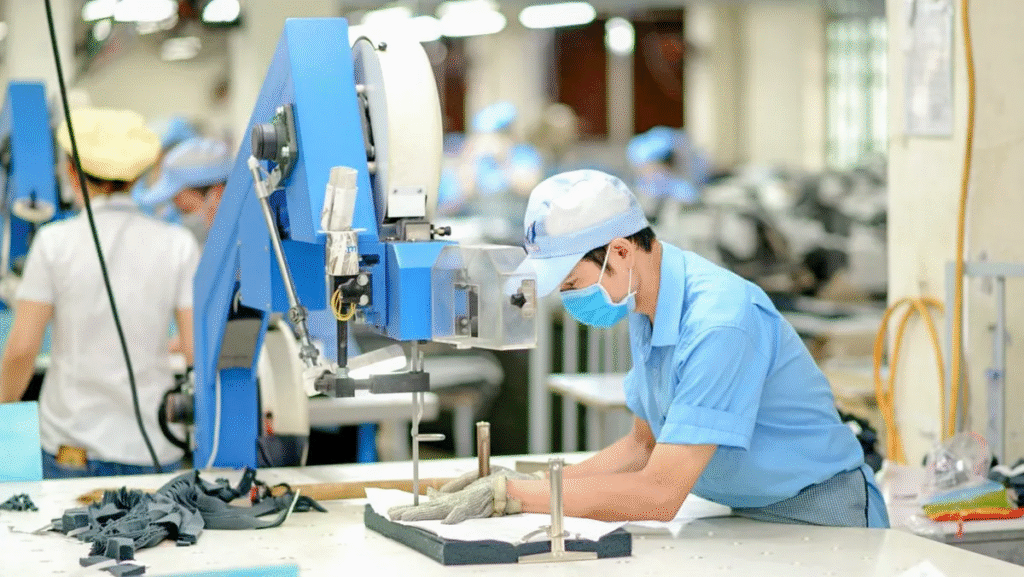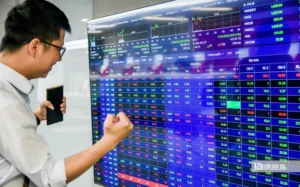Ho Chi Minh City has identified that tapping private investment capital is the key to achieving its growth target. By 2025, the city needs to mobilize VND465,000 billion from the private sector.
Nearly 1.8 million billion VND is the Gross Regional Domestic Product (GRDP) of Ho Chi Minh City in 2024. More than 27,000 times larger than the economic scale of the City in 1986, the year the Doi Moi started. Showing the strong development, great achievements and economic leadership position of Ho Chi Minh City in the 50 years since the country’s reunification.
During the period from 1992 to 1997, the City’s economic growth reached an average double-digit rate of 13%, affirming its position and role as the economic locomotive of the whole country. This is the result of a period of innovation since 1986. First of all, the decisions were considered “breaking the rules”.
Mr. Pham Chanh Truc – Former Deputy Head of the Central Economic Committee, Former Standing Deputy Secretary of the Ho Chi Minh City Party Committee said: “At that time, comrade Vo Van Kiet was the Secretary of the City Party Committee. Seeing the difficult situation, the industrial economy stagnated, the organization went down to the factories to find solutions on how to restore these factories.”
Mr. Pham Chanh Truc recounted that the City had come up with an initiative to organize the borrowing of foreign currency, USD, and gold from the people to import raw materials and supplies for production, in cooperation with factories. After that, the City would exchange the products for food, exportable goods, and use foreign currency to re-import raw materials for the factories.
“That’s how we start the cycle, starting from the factory and spreading to other places. The word “fence breaking” broke out, and at that time comrade Vo Van Kiet was the pioneer, daring to do, daring to take responsibility, and then comrade Nguyen Van Linh organized for the Politburo to listen and see the reality, and all comrades agreed that the way of doing it was right”, said Mr. Pham Chanh Truc – Former Deputy Head of the Central Economic Commission, Former Standing Deputy Secretary of the Ho Chi Minh City Party Committee.
Ms. Mai Kieu Lien – General Director of Vietnam Dairy Products Company Vinamilk said: “Starting from 1975 to 1986 was a whole process that the City jokingly called “breaking the fence” contributing to creating the innovation policies of our Vietnamese state, typically the 6th Congress – the innovation congress, at that time officially gave autonomy to all businesses and economic sectors, which was a very important step, I think thanks to that, we have Ho Chi Minh City and the current market economy”.
During the 2002-2008 period, the City’s economy continued to grow at double-digit rates, thanks to two important milestones: the formation of Export Processing Zones and High-Tech Zones that officially opened to foreign capital.
Second, the birth of Vietnam’s first Enterprise Law in 2000 created a clear and transparent legal environment for the private economy , followed by a series of equitized state-owned enterprises, creating momentum for breakthrough developments to date.
Mr. Pham Chanh Truc – Former Deputy Head of the Central Economic Commission, Former Standing Deputy Secretary of the Ho Chi Minh City Party Committee said: “The three forces that have the conditions to bring production to industrialization and modernization, that is, large-scale production, are state-owned enterprises, private enterprises, and foreign-invested enterprises”.
“At that time, we were a very special unit, that is, from a branch that was allowed by the State to be equitized, this was an unusual thing! But because at that time, very few enterprises were willing to be equitized, we did it and the City supported us, such as not having to pay corporate income tax for 10 years of equitization. We also had an additional 5 years of only having to pay 50%. That was the decision that helped us change our thinking and bravely participate in equitization. We turned the unthinkable into reality! It must be said that only the City could help us have those mechanisms, and thanks to the City, we had breakthroughs from a very small State-owned enterprise to become the leading enterprise in the country”, said Mr. Do Ha Nam – General Director of Intimex Company.
Mr. Pham Chanh Truc – Former Deputy Head of the Central Economic Commission, Former Standing Deputy Secretary of the Ho Chi Minh City Party Committee shared: “The whole City has a tradition of finding ways to overcome difficulties and never giving up! That is the dynamic tradition of the City from the resistance war until after liberation.”
Bottlenecks holding back economic locomotives
Ho Chi Minh City’s economy has been growing at double digits continuously. However, since 2011, the city’s economy has been growing slowly and stagnant due to many reasons, both objective and subjective. Analyzing the growth of the three traditional driving forces: Investment – Export – Consumption, experts say that the investment driving force is facing the most challenges.
Ho Chi Minh City’s business environment has faced many difficulties in recent years. In the first quarter, the number of businesses entering the market decreased by more than 20%, while the number of businesses withdrawing increased by more than 10% compared to the same period in 2024. Experts say that after the Covid-19 pandemic, private investment has slowed down due to many difficulties and fluctuations in the world economy. Meanwhile, according to the Provincial Competitiveness Index rankings, Ho Chi Minh City has tended to decline in recent years. This shows that the business environment is not really favorable for businesses.
Foreign direct investment is the driving force behind Ho Chi Minh City’s economic locomotive. To date, the City’s accumulated foreign direct investment has reached more than 58 billion USD, leading the country. However, the flow of foreign investment into the City has slowed down in recent years due to limited land funds, overloaded infrastructure and slow administrative reform, making the City less competitive compared to other localities in the Southeast and the Northern coastal region.
As a result, the city’s export proportion in the country’s total export turnover is now only over 10%, while this figure in the previous period was up to 50%. Overall, Ho Chi Minh City’s contribution to the country’s Gross Domestic Product is now 15%, a significant decrease compared to the previous level of over 20%.
Ho Chi Minh City triggers new growth “wave”
Faced with new development requirements, the City’s economy will need to regain its double-digit annual growth trajectory in the coming time. Currently, the implementation of synchronous solutions to be able to activate the next “wave” of growth for Ho Chi Minh City is very urgent.

Beside, a Dutch manufacturer of machinery used in the semiconductor packaging process, has invested nearly $5 million in the first phase in Ho Chi Minh City. To meet cost requirements, the company needs to source 80% of its supplies from Vietnam.
Mr. Steven Lim – Vice President of Research and Development for Asia, Besi Company said: “We need to develop a domestic supply chain. This will play an important role for Vietnam. Because when we expand our business, Vietnamese enterprises will also grow, bringing mutual benefits when participating in the semiconductor industry supply chain”.
This is one of the typical examples of how Ho Chi Minh City will attract investment capital in the coming period. That is, choosing strategic investors: that is, in the high-tech sector, and creating conditions for Vietnamese enterprises to participate in the global value chain of investors.
The City Government has identified that mobilizing and unlocking private investment capital is the key to achieving the double-digit growth target in the coming period. This year alone, the City will need to mobilize VND465,000 billion from the private sector (including foreign direct investment) to achieve the growth target. This includes promptly removing obstacles for more than 570 pending projects and works.
Mr. Nguyen Xuan Thanh – Senior Lecturer at the School of Public Policy and Management, Fulbright University Vietnam said: “It requires an important signal based on removing legal barriers for the real estate market. Policy commitments and institutional innovation to reduce legal risks for businesses”.
To create a better business investment environment, the City government is currently promoting the reduction of at least 30% of both the number of administrative procedures with unnecessary business conditions and the time to carry out the procedures. Moving towards building a one-stop mechanism to carry out investment procedures.
Mr. Nguyen Van Dung – Vice Chairman of Ho Chi Minh City People’s Committee said: “In terms of institutions, the City will focus on implementing the best administrative reforms in the area, to create an open and favorable environment for the business community”.
“The main goal of our current streamlining of the apparatus is to serve the people and businesses. So we need to legalize and institutionalize the decentralization of power to local leaders at the commune level to decide on issues that the people need. That is the direction in which we are reforming,” said Associate Professor, Dr. Tran Hoang Ngan – National Assembly Delegate of Ho Chi Minh City.
The City government is also studying to soon deploy the use of public investment capital as a lever to stimulate private investment in the fields of science, technology and innovation. These are fields with high added value, capable of creating breakthroughs to complete the growth target.
An important basis for Ho Chi Minh City to be able to achieve the double-digit growth target in the coming time: that is, in recent years, from the Central to the City, efforts have been made to remove many institutional bottlenecks and concretize specific mechanisms. In the new context after the revolution of streamlining the organizational apparatus, the scale of the new Ho Chi Minh City after the merger can reach 1/4 of the country’s GDP, the business community and experts all expect these mechanisms to be implemented smoothly, without interruption. Helping the economic locomotive to make a successful breakthrough.
















